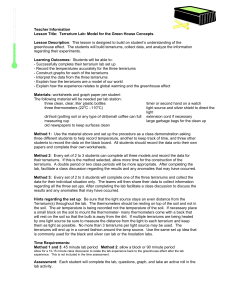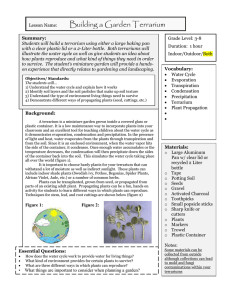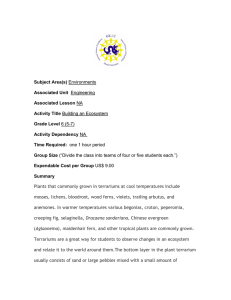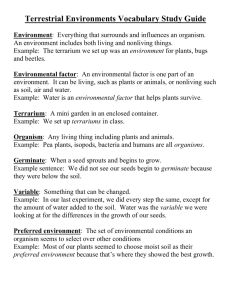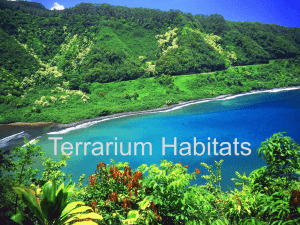Teacher Information Lesson Description
advertisement
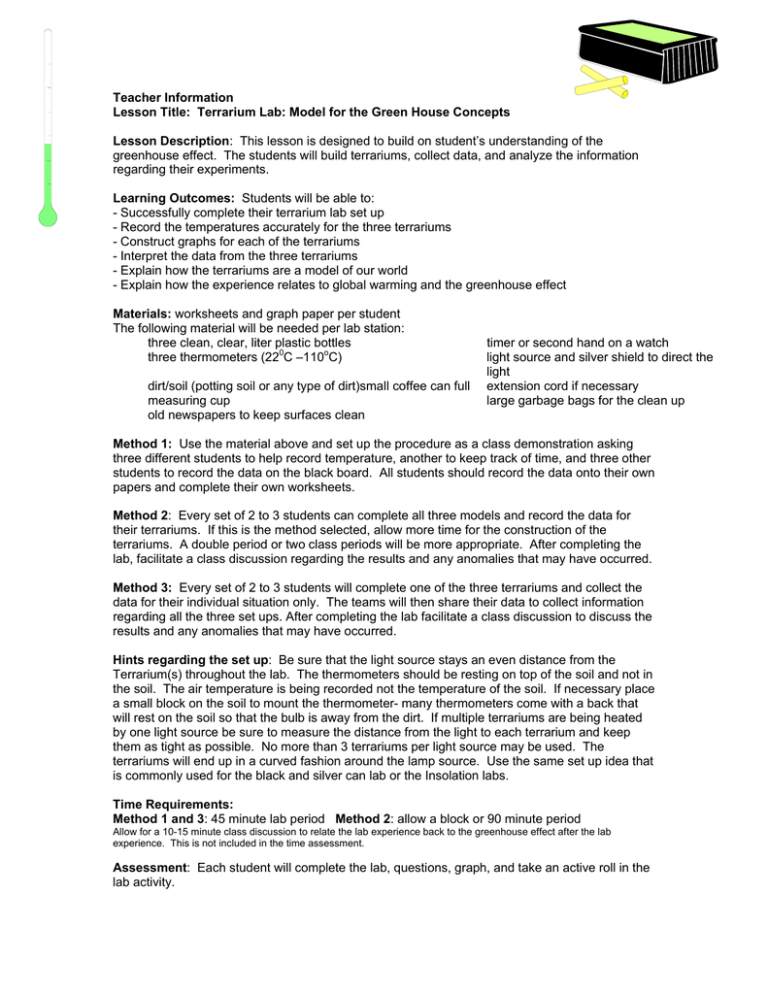
Teacher Information Lesson Title: Terrarium Lab: Model for the Green House Concepts Lesson Description: This lesson is designed to build on student’s understanding of the greenhouse effect. The students will build terrariums, collect data, and analyze the information regarding their experiments. Learning Outcomes: Students will be able to: - Successfully complete their terrarium lab set up - Record the temperatures accurately for the three terrariums - Construct graphs for each of the terrariums - Interpret the data from the three terrariums - Explain how the terrariums are a model of our world - Explain how the experience relates to global warming and the greenhouse effect Materials: worksheets and graph paper per student The following material will be needed per lab station: three clean, clear, liter plastic bottles three thermometers (220C –110oC) dirt/soil (potting soil or any type of dirt)small coffee can full measuring cup old newspapers to keep surfaces clean timer or second hand on a watch light source and silver shield to direct the light extension cord if necessary large garbage bags for the clean up Method 1: Use the material above and set up the procedure as a class demonstration asking three different students to help record temperature, another to keep track of time, and three other students to record the data on the black board. All students should record the data onto their own papers and complete their own worksheets. Method 2: Every set of 2 to 3 students can complete all three models and record the data for their terrariums. If this is the method selected, allow more time for the construction of the terrariums. A double period or two class periods will be more appropriate. After completing the lab, facilitate a class discussion regarding the results and any anomalies that may have occurred. Method 3: Every set of 2 to 3 students will complete one of the three terrariums and collect the data for their individual situation only. The teams will then share their data to collect information regarding all the three set ups. After completing the lab facilitate a class discussion to discuss the results and any anomalies that may have occurred. Hints regarding the set up: Be sure that the light source stays an even distance from the Terrarium(s) throughout the lab. The thermometers should be resting on top of the soil and not in the soil. The air temperature is being recorded not the temperature of the soil. If necessary place a small block on the soil to mount the thermometer- many thermometers come with a back that will rest on the soil so that the bulb is away from the dirt. If multiple terrariums are being heated by one light source be sure to measure the distance from the light to each terrarium and keep them as tight as possible. No more than 3 terrariums per light source may be used. The terrariums will end up in a curved fashion around the lamp source. Use the same set up idea that is commonly used for the black and silver can lab or the Insolation labs. Time Requirements: Method 1 and 3: 45 minute lab period Method 2: allow a block or 90 minute period Allow for a 10-15 minute class discussion to relate the lab experience back to the greenhouse effect after the lab experience. This is not included in the time assessment. Assessment: Each student will complete the lab, questions, graph, and take an active roll in the lab activity. Willow Biomass Modules SUNY College of Environmental Science and Forestry Student Lab Activity Terrarium Lab Model for Green House Concepts Name _____________________ Partner(s) initials ______________ Date _____ Materials Needed: Every student will need the lab worksheet and graph paper Per team 3 one or two liter, plastic soda bottles (all the same size) 4 thermometers (includes 22 0c to 110 0c) spotlight or light source for heat with silver shield piece of 4in square grass 6 cups of soil or dirt 3 cups of water Directions: In teams of three, each person will make one of the following containers. Container 1: No Lid Use an empty and clean 1 liter bottle (others sizes will work just make sure all three are the same size). Cut the bottle evenly around the top about 1/3 of the way down. When completed, throw out the cover and cap. Fill the bottom half full of soil and pour in 1/2 cup of water. Place a thermometer (range should cover 22 0C to 110 0c) on top of the soil so that it can be easily read every 3 to 5 minutes. Container 2: Soil and Lid Use an empty and clean 1 liter bottle. Cut the bottle evenly around the top about 1/3 of the way down. Set the top with cover still on aside until later. Fill the bottom half full of soil and pour in 1/2 cup of water. Place a thermometer (range should cover 22 0C to 110 0c) on top of the soil so that it can be easily read every 3 to 5 minutes. Cover the top of the bottle by folding in the edges and applying the top back onto the bottom. It will not be perfectly airtight and to do this the edges will be a little bent but with small force you should be able to do this without tipping over your set up.☺ Add a clear tape around the seal to make it more air tight. Container 3: Soil, Lid and Grass Will the true Terrarium show off? Use an empty and clean 1 liter bottle. Cut the bottle evenly around the top about 1/3 of the way down. Set the top with cover still on aside until later. Fill the bottom half full of soil with grass on top. pour in 1/2 cup of water. Place a thermometer (range should cover 22 0 C to 110 0c) on top of the soil so that it can be easily read every 3 to 5 minutes. Cover the top of the bottle by folding the edges in some and applying the top back on. It will not be perfectly airtight and to do this the edges will be a little bent but with small force you should be able to do this without tipping over your set up, smile. 1 Willow Biomass Modules SUNY College of Environmental Science and Forestry Student Lab Activity Problem: Given the same energy input, which container designed will increase its’ temperature the most? Why? Key points: Is air or soil temperature being measured in each container? Record your first set of data temperatures before the light source is turned on Hypothesis: What are your ideas about the outcome? _________________ Procedure: Place your three containers an even distance from your lamp source (12 inches). Have your lamp mounted so that it strikes the bottles from the side view not the top. Record the initial temperatures before the light is turned on. Then record the three container’s temperatures every 3 minutes (check with your instructor, they may want to change this to 5 minutes?) Your instructor will tell you how many recordings to complete. Data/Results: Make a table to record your results. Make the table easy to read and clearly labeled. #1 no lid #2 lid and soil #3 lid, soil, grass Initial 3 min 6 9 12 15 18 21 24 Graph your data and be sure to turn this in with the lab write up. 2 Willow Biomass Modules SUNY College of Environmental Science and Forestry Student Lab Activity Conclusion: Based on the data make one or more conclusions about the activity. Results: This will be completed within a class discussion directed by the instructor. A) Which container increased in temperature the most? B) Which container increased in temperature the most rapidly? C) Which container was the most stable in temperature? D) Explain the results: ____________________________________________ After listening to the discussion about the “Greenhouse Effect and Global Warming”, explain how this activity relates to these theories. 3

